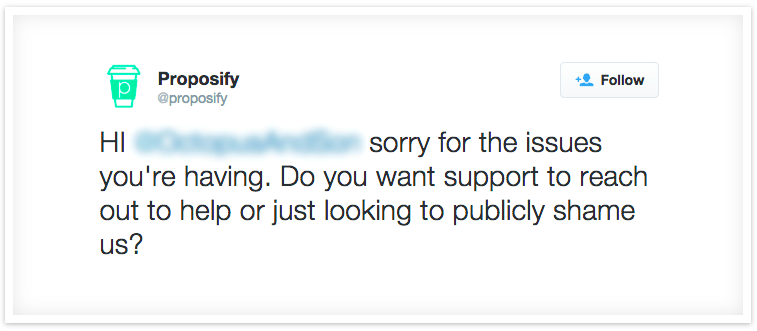Tough conversations are a part of life and in business, it’s no different. But tough customer conversations can be just that – tough.
In customer service, you’re bound to come across a difficult situation or two. People have bad days, get confused, and things go wrong. Angry, difficult, and dissatisfied customers aren’t necessarily a reflection of how well your business is run (because people are, well, people).
Often these scenarios are the result of miscommunication and misaligned expectations. Regardless, knowing how to respond and passing that knowledge down to your team so that they can navigate the choppy waters is necessary if you want to keep your business afloat. Especially nowadays when it only takes a few clicks of a mouse to publicly shame a business. But, statistics show that, even though only 4% of clients complain to you, up to 80% of those dissatisfied clients will tell approximately 10 people about it. This number isn’t drastically high, but no one wants to lose clients.
The point is, whether a customer is coming upset because you’re out of stock of the item they want, they want to request a feature that’s not available, they’re just generally unhappy with your product or service.
The way you and your customer support team handle a situation can mean the difference between whether that customer remains a customer.
With a little help from these tried and true conflict resolution techniques, you’ll be on your way to creating a win-win for both parties. Or at least avoiding angry tweets and reviews.
 Silence Your Judgements
Silence Your Judgements
I don’t know about you, but if someone is yelling, impatient, condescending, or even unintentionally short with their words, my first instinct is to interject with a piece of my mind. But this is the workplace we’re talking about. Responding with our initial gut reaction without thinking or listening, usually isn’t the best route to take.
Instead of acting on instinct, take a moment to acknowledge the assumptions of the other person. As they say, impact doesn’t always mean intent. So even though you might feel belittled or misunderstood, know that 9 times out of 10 wasn’t the customer’s intention.
“If your client keeps complaining and cringing when you speak or is constantly confronting you in writing, try to mirror their terms or discreetly adjust yours to get somewhere in the middle. When you try to be more careful with your words, the other person will notice and automatically try to do the same.” – explains Frank Green, an HR manager at Aussie Writings.
Try to take a walk in their shoes and prepare yourself to listen to their side of the story. Think about how you or your team may have contributed to the issue (like a bug your team has been working on, but it still isn’t fixed)? How might the customer be perceiving the situation?
The moral being, check your attitude at the door and remember that in customer support, your job is to help resolve problems. That’s not to say the customer is always right, but remember, they’re human too and when you act on an impulse or with a negative attitude, it reflects on the direction of the conversation. So for the sake of avoiding hostile situations, take a couple of deep breaths and get ready to listen to their side of the story.
 Practice Active Listening
Practice Active Listening
Active listening is a soft skill must have as a support team member. It sounds like common sense, but you’d be surprised at how often the listening element is missing in customer conversations.
Listening is especially critical because more often than not, you only get a snippet of a customer’s issue when they contact you before you speak to them. So you don’t know the whole story.
That being said, before you start problem-solving let whoever you’re speaking air it all out. Your job at that moment is to say nothing but learn as much as possible about what’s going on from their point of view.
Every client wants to make sure that customer complaints are heard and taken care of. The best thing you can do is to never hesitate to provide them with the needed amount of attention and show them that you care about what they have to say.
Active Listening Techniques
It’s been said we only remember between 25 and 50 percent of what we hear which is why active listening is a great practice to enforce. Some examples of active listening techniques are:
- Pay attention (duh!). While you’re letting them share their problems, look at them directly if you’re in person, avoid preparing a response ahead of time. Let them know they have your undivided attention.
- Be body language conscious. A simple nod or smile and eye contact (not the overly creepy kind) can make all the difference. It’s obvious when people aren’t paying attention.
Once you’ve listened to what they have to say active listening can look like:
- Say you’re sorry! This is not a time for pride to get in the way. If you and your team are at fault, over-promised and under-delivered, or just made a simple mistake. Own up to it! It may not undo the situation but it can certainly build trust and rapport as well as ease the tension.
- Ask questions. If you’re not sure what they mean by something or are unclear what exactly they need from you, ask! Don’t guess. Let them know you truly want to help but need more information before you can do so properly. In the best-case scenario, your willingness to hear them out and eagerness to help in the best way possible will slowly start moving them out of that dissatisfied state.
 Learn to Acknowledge without Agreeing
Learn to Acknowledge without Agreeing
You need to acknowledge your customers, but you don’t have to agree with what they say. When a customer keeps adding fuel to the fire, acknowledge what they say and shift the conversation rapidly. In this way, you can avoid ruining your business because of a small communication problem.
Imagine that you are a lawyer. If a client keeps making statements like ‘It is always like this with lawyers’, you can simply acknowledge that by saying ‘I see your point, but let’s focus on what we can do to fix your issue first’. You will certainly not agree with such statements, but acknowledging it can go a long way.
You don’t always have to tolerate the emotional drain of customers. But, whenever you can, attempt to fix the relationship before you rush into eliminating it.
 Implement FRomLE technique
Implement FRomLE technique
Have you heard of the FroMle Technique? It is the perfect technique to use for annoying people, including difficult customers you cannot stand.
This technique is specifically created to get you through those painful and difficult conversations. The phrase means from my limited experience and is not to be said out loud. This is a type of silent psychological technique that will help you soften the blows from clients for your benefit.
A client of yours says something offensive or a bit mean to you. Listen to this statement and just add the FroMLE to the end in your mind. For example, if you are a translator and one of your clients keeps saying how translators take money for a job a computer can make, this will probably infuriate you and insult you. Some people simply do not understand the effort a good translator puts into their job. If this happens to you, try to tack on the FroMLE technique of the statement they made in your head.
This will not make the insult any smaller, but it should help soften the blow. And, it could save you a great deal with an important customer you would lose if you burst with anger.
 Resolve And Follow Up
Resolve And Follow Up
A big part of having your customers come back for your services is to always make sure they leave the conversations with you happy. It is very important that through your customer support your earn their trust and respect and make them feel respected as well.
A perfect example of how to resolve an issue the right way using the outlined techniques can be found in this detailed post by GrooveHQ.
Here’s a quick summary:
An angry customer reached out via Twitter with a semi-condescending comment about Proposify’s (the business the story is centered around) product. Regardless of the customer’s tone, the Proposify crew immediately responded. They asked if they’d like to speak with support, which they did. Once they moved the situation to email, the propensity team was able to hear out the customer. They get their side of the story and ask clarifying questions about how they could better solve the problem.

In the end, Kyle, the founder of Proposify not only listened, but also responded appropriately, and gave a genuine apology. He also included a free month of service for their troubles which were the cherry on top. An above and beyond move that’s not always required, but I don’t think it would have had the same effect if he had simply just offered free product without caring about the actual issue.

Even if something does go wrong, you should always do everything in your power to resolve issues. The more you try to assist your customers, the more they will see how much care you put into your services and that’s the most important thing when it comes to building a relationship with them.
Following up should also be on your list of to-dos after resolving an issue. Whether it be a couple of days or weeks after (depending on the situation) this is a fantastic way to boost customer retention. Reach out to see how things are working for them. You can use their feedback as a way to improve your services, products, or anything else they really were unhappy with.
The point here is to find a way of communicating with them that works and to stick to it. Always be respectful, be kind, and as helpful as possible. By maintaining consistency with providing your clients with top-notch service, you’ll eventually see your company’s reputation flourish.
We’re Only Human
Delivering great customer service and solving customer issues isn’t about being a perfect company and never dealing with drama. That’s pretty much an impossible standard to set.
A much simpler road to take is to be prepared for these kinds of situations and implementing these helpful communication skills into you and your team’s support repertoire. Then learning from the situations and improving as you go.









